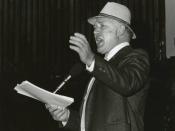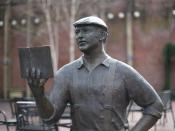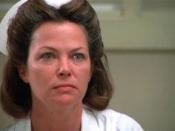One Flew Over the Cuckoo's Nest, with its meaningful message of individualism, was an extremely influential novel during the 1960's. In addition, its author, Ken Kesey, played a significant role in the development of the counterculture of the 60's; this included all people who did not conform to society's standards, experimented in drugs, and just lived their lives in an unconventional manner. Ken Kesey had many significant experiences that enabled him to create One Flew Over the Cuckoo's Nest. As a result of his entrance into the creative writing program at Stanford University in 1959 (Ken 1), Kesey moved to Perry Lane in Menlo Park. It was there that he and other writers first experimented with psychedelic drugs. After living at Perry Lane for a while, Kesey's friend, Vik Lovell, informed him about experiments at a local V.A. hospital in which volunteers were paid to take mind-altering drugs (Wolfe 321).
Kesey's experiences at the hospital were his first step towards writing Cuckoo's Nest. Upon testing the effects of the then little-known drug, LSD, '...he was in a realm of consciousness he had never dreamed of before and it was not a dream or delirium but part of his awareness (322).' This awareness caused him to believe that these psychedelic drugs could enable him to see things the way they were truly meant to be seen.
After working as a test subject for the hospital, Kesey was able to get a job working as a psychiatric aide. This was the next significant factor in writing the book. 'Sometimes he would go to work high on acid (LSD) (323).' By doing so, he was able to understand the pain felt by the patients on the ward. In addition, the job allowed him to examine everything that went on within the confines of...


